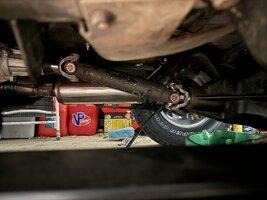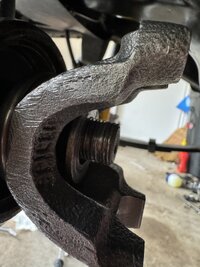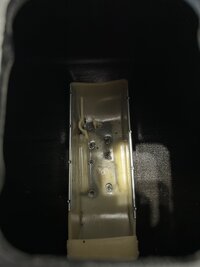Last I left off on the Dana 35 was that I received my larger 7/16” bolts which is what the factory upsized to somewhere around 2001 or so.
I started working on the setup, initially reusing the factory pinion shim of 0.041”. The shims provided in my spicer shim kit were only ranging from 0.041-0.046 in 0.001 increments, so they definitely don’t expect you to need to mess with pinion shim much.
After running a bunch of patterns and different carrier shim sizes, I landed here:
View attachment 122664
View attachment 122665
I think this will run solid. I’m not a fan of the carrier shims I had to use though. The factory setup is just a thick shim per side (0.160-0.165ish), outside the bearing. This is ideal and super easy to deal with if you ever need to disassemble in the future.
Spicer’s intent for future setup service is to give you 2 0.150” master shims and then smaller ones to slip under the bearings. That’s all fine and good….if you’re using the stock carrier.
Eaton doesn’t make a perfect carrier. Or at least, it doesn’t match the specs of the Spicer carriers very well. I found that using either the stock 0.161 shim or the 0.150 service shim on the left (ring gear) side gave me no backlash at all. Jammed the ring gear too tight into the pinion. So I bought a Revolution Gear master kit. The shims in it were decent. I don’t like hammering in 6 small shims per side when installing the carrier but whatever, I don’t plan to go back in there for a long time.
I also found that the TT carrier was a bit smaller than stock. I installed it with the two stock shims and factory bearings and it slipped right in. No preload at all. So essentially during the setup I added more shim than stock and I packed a lot of that in the right side because the left side needed significantly less shim than stock in order to achieve any backlash at all.
Finished the diff setup, installed new Spicer wheel bearings and seals, and greased the bearings a bit. Got the diff filled up with excess oil when it was in the stands and ran it with a drill for 5 minutes or so to lube everything up nicely.
View attachment 122666
The final thing to deal with was the the c-clip spacer button. The one Eaton supplies is too small. It allows slop and then the axle shafts slide back and forth. Since it’s not like stock with a center pin keeping the left and right shafts in their respective areas, it makes for a lot of unwanted racket. It also can cause the driver to have to counter steer from the rear shifting around.
I found a guy on YouTube who had the same problem. He made himself a new spacer on a lathe out of chromoly and quenched it to make it hard. I reached out and he was willing to make me one as well for a very fair price. Went from 0.686 to 0.732 thickness. That took the slop from 0.058 down to 0.012. MUCH better. With gear lube there is almost no slop at all, and the little bit of clearance left will be good for the expansion of all the metals when they heat up. Definitely don’t want the button causing pressure on the axle shafts.
View attachment 122667
That’s about all for the Dana 35. I used a new 1310 yoke. I wanted to use a 1330 to “keep it 1994”, but the options weren’t good. I bought one from Denny’s (it’s a replica of the original since Spicer discontinued the original), and it was okay but it didn’t fit the pinion as snugly and when I spin it with a drill it seemed like it wasn’t symmetrical. I trusted the Spicer 1310 more, so I went with it.
Plus, 1330 is a longer yoke which means shorter driveshaft. It is hard to find a 94-95 driveshaft from eBay since they are only two years. So for used shafts, 1330 limited me. I found a good quality 1310 almost immediately. So I bought it and went with the 1310 yoke.
View attachment 122668
Still need to hook up parking brake cables, bleed the brakes and probably adjust the drums. But at least it’s in.


















